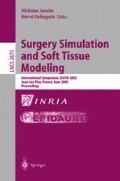Abstract
Realistic generation of variable anatomical organ models and pathologies are crucial for a sophisticated surgical training simulator. A training scene needs to be different in every session in order to exhaust the full potential of virtual reality based training. We previously reported on a cellular automaton able to generate leiomyomas found in the uterine cavity. This paper presents an alternative approach for the design of macroscopic findings of pathologies and describes the incorporation of these models into a healthy virtual organ. The pathologies implemented are leiomyomas and polyps protruding to different extents into the uterine cavity. The results presented are part of a virtual reality based hysteroscopy simulator that is under development.
Access this chapter
Tax calculation will be finalised at checkout
Purchases are for personal use only
Preview
Unable to display preview. Download preview PDF.
References
M. Bajka. Empfehlungen zur Gynäkologischen Sonographie. Schweizerische Gesellschaft für Ultraschall in der Medizin, 2001.
H. Blum. A transformation for extracting new descriptors of shape. Models for the Perception of Speech and Visual Form. MIT Press, pages 362–380, 1967.
Cootes et al. Active Shape Models-Their Training and Application. Computer Vision and Image Understanding, 61(1):38–59, 1995.
D’Arcy W. Thompson. On Growth and Form, Volume I,II. Cambridge University Press, 1952.
G. Farin. Curves and Surfaces for CAGD. A practical guide. Academic Press, San Diego, USA, fourth edition, 1997.
G. Székely et al. Virtual Reality-Based Simulation of Endoscopic Surgery. Presence, 9(3): 310–333, 2000.
Kelemen et al. Elastic Model-Based Segmentation of 3-D Neororadiological Data Sets. IEEE Transactions on Medical Imaging, 18(10):828–839, 1999.
K. Montgomery et al. Surgical Simulator for Hysteroscopy: A Case Study of Visualization in Surgical Training. IEEE Visualization 2001, 2001.
C. Kuhn. Modellbildung und Echtzeitsimulation deformierbarer Objekte zur Entwicklung einer interaktiven Trainingsumgebung für Minimal-Invasive Chirurgie. Forschungszentrum Karlsruhe GmbH, Karlsruhe, 1997.
R. Kurman and M. Mazur. Blaustein’s Pathology of the Female Genital Tract. Springer, Berlin, New York, fourth edition, 1990.
S. Kyriacou et al. Nonlinear Elastic Registration of Brain Images with Tumor Pathology Using a Biomechanical Model. IEEE Transactions on Medical Imaging, 18(7):580–592, 1999.
W. Lorensen and H. Cline. Marching Cubes: A High Resolution 3D Surface Construction Algorithm. Computer Graphics, 21(4):163–170, 7.1987.
S. Pizer et al. Multiscale Medial Loci and Their Properties. Int. J. Comp. Vision, accepted 2002.
Pschyrembel, Strauss, and Petri. Praktische Gynäkologie für Studium, Klinik und Praxis. de Gruyter, Berlin, New York, fifth edition, 1990.
R. Sierra, G. Sz’ekely, and M. Bajka. Generation of Pathologies for Surgical Training Simulators. MICCAI, Proceedings, Part II:202–210, 2002.
Journal of Obstetrics and Gynecology of India. http://www.journal-obgynindia.com/issue_march_april2001/g_papers_115.htm, 2002.
Author information
Authors and Affiliations
Editor information
Editors and Affiliations
Rights and permissions
Copyright information
© 2003 Springer-Verlag Berlin Heidelberg
About this paper
Cite this paper
Sierra, R., Bajka, M., Székely, G. (2003). Pathology Design for Surgical Training Simulators. In: Ayache, N., Delingette, H. (eds) Surgery Simulation and Soft Tissue Modeling. IS4TM 2003. Lecture Notes in Computer Science, vol 2673. Springer, Berlin, Heidelberg. https://doi.org/10.1007/3-540-45015-7_36
Download citation
DOI: https://doi.org/10.1007/3-540-45015-7_36
Published:
Publisher Name: Springer, Berlin, Heidelberg
Print ISBN: 978-3-540-40439-2
Online ISBN: 978-3-540-45015-3
eBook Packages: Springer Book Archive

